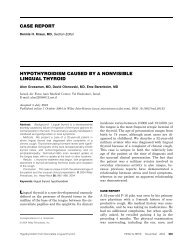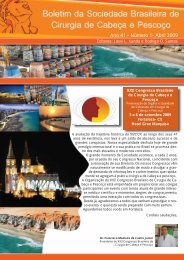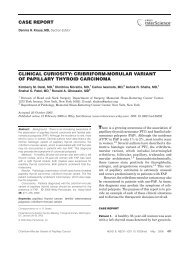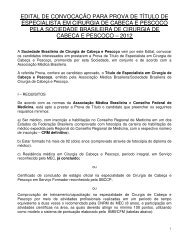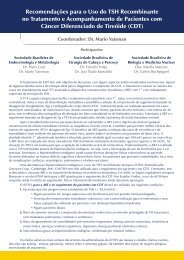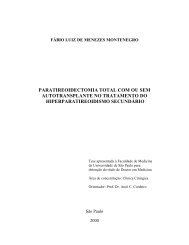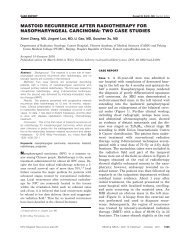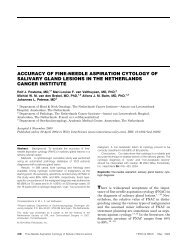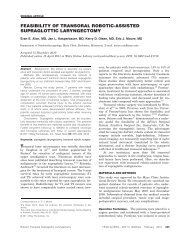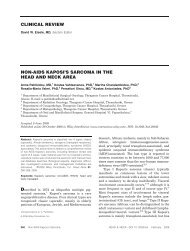Validation of the EORTC QLQ-C30 and EORTC QLQ-H&N35 in ...
Validation of the EORTC QLQ-C30 and EORTC QLQ-H&N35 in ...
Validation of the EORTC QLQ-C30 and EORTC QLQ-H&N35 in ...
You also want an ePaper? Increase the reach of your titles
YUMPU automatically turns print PDFs into web optimized ePapers that Google loves.
ORIGINAL ARTICLE<br />
VALIDATION OF THE <strong>EORTC</strong> <strong>QLQ</strong>-<strong>C30</strong> AND <strong>EORTC</strong><br />
<strong>QLQ</strong>-H&<strong>N35</strong> IN PATIENTS WITH LARYNGEAL<br />
CANCER AFTER SURGERY<br />
Susanne S<strong>in</strong>ger, PhD, 1 Dorit Wollbrück, Dipl-Psych, 1 Cornelia Wulke, MD, 2 Andreas Dietz, MD, 3<br />
Eckart Klemm, MD, 4 Jens Oeken, MD, 5 Eberhard F. Meister, MD, 6 Hilmar Gudziol, MD, 7<br />
Julian B<strong>in</strong>dewald, 1 <strong>and</strong> Re<strong>in</strong>hold Schwarz, MD 1<br />
1 Department <strong>of</strong> Social Medic<strong>in</strong>e, University <strong>of</strong> Leipzig, Leipzig, Germany.<br />
E-mail: susanne.s<strong>in</strong>ger@mediz<strong>in</strong>.uni-leipzig.de<br />
2 Department <strong>of</strong> Otorh<strong>in</strong>olaryngology, University <strong>of</strong> Halle-Wittenberg, Halle, Germany<br />
3 Department <strong>of</strong> Otorh<strong>in</strong>olaryngology, University <strong>of</strong> Leipzig, Leipzig, Germany<br />
4 Department <strong>of</strong> Otorh<strong>in</strong>olaryngology, Hospital Dresden-Friedrichstadt, Dresden, Germany<br />
5 Department <strong>of</strong> Otorh<strong>in</strong>olaryngology, Cl<strong>in</strong>ical Center Chemnitz, Chemnitz, Germany<br />
6 Department <strong>of</strong> Otorh<strong>in</strong>olaryngology, Hospital St. Georg, Leipzig, Germany<br />
7 Department <strong>of</strong> Otorh<strong>in</strong>olaryngology, University <strong>of</strong> Jena, Jena, Germany<br />
Accepted 5 June 2008<br />
Published onl<strong>in</strong>e 28 October 2008 <strong>in</strong> Wiley InterScience (www.<strong>in</strong>terscience.wiley.com). DOI: 10.1002/hed.20938<br />
Abstract: Background. The aim <strong>of</strong> this study was to test <strong>the</strong><br />
validity <strong>of</strong> <strong>the</strong> European Organization for Research <strong>and</strong> Treatment<br />
<strong>of</strong> Cancer Quality <strong>of</strong> Life Questionnaire, Core Module<br />
(<strong>QLQ</strong>-<strong>C30</strong>) <strong>and</strong> Head <strong>and</strong> Neck Module (<strong>QLQ</strong>-H&<strong>N35</strong>) for<br />
patients who have undergone surgery due to laryngeal cancer.<br />
Methods. A total <strong>of</strong> 323 patients from 6 different centers <strong>in</strong><br />
Germany who had been operated on completed <strong>the</strong> <strong>QLQ</strong>-<strong>C30</strong><br />
<strong>and</strong> <strong>the</strong> <strong>QLQ</strong>-H&<strong>N35</strong> <strong>in</strong> addition to be<strong>in</strong>g surveyed <strong>in</strong> a personal<br />
<strong>in</strong>terview.<br />
Results. Multitrait scal<strong>in</strong>g analysis confirmed <strong>the</strong> proposed<br />
scale structure <strong>of</strong> both questionnaires. Cronbach’s alpha <strong>of</strong> <strong>the</strong><br />
<strong>QLQ</strong>-<strong>C30</strong> scales ranged from 0.64 (Cognitive Function<strong>in</strong>g) to<br />
0.94 (Global Health Status); <strong>the</strong> alpha <strong>of</strong> <strong>the</strong> <strong>QLQ</strong>-H&<strong>N35</strong><br />
ranged from 0.55 (Speech) to 0.90 (Sexuality). Known-groups<br />
comparisons showed multiple differences <strong>in</strong> sociodemographic<br />
<strong>and</strong> cl<strong>in</strong>ical variables.<br />
Conclusion. It can be concluded that <strong>the</strong> <strong>QLQ</strong>-H&<strong>N35</strong>, <strong>in</strong><br />
conjunction with <strong>the</strong> <strong>QLQ</strong>-<strong>C30</strong>, is a reliable <strong>in</strong>strument that is<br />
able to differentiate between diverse groups <strong>of</strong> patients with laryngeal<br />
cancer after surgery. VC 2008 Wiley Periodicals, Inc.<br />
Head Neck 31: 64–76, 2009<br />
Keywords: validation; health-related quality <strong>of</strong> life; laryngeal<br />
cancer; <strong>EORTC</strong> <strong>QLQ</strong>-H&<strong>N35</strong>; <strong>EORTC</strong> <strong>QLQ</strong>-<strong>C30</strong><br />
Correspondence to: S. S<strong>in</strong>ger<br />
This work was presented at <strong>the</strong> Conference <strong>of</strong> <strong>the</strong> Mult<strong>in</strong>ational Association<br />
<strong>of</strong> Supportive Care <strong>in</strong> Cancer, St. Gallen, Switzerl<strong>and</strong>, 2007.<br />
Contract grant sponsor: German Federal M<strong>in</strong>istry <strong>of</strong> Education <strong>and</strong><br />
Research; contract grant number: 7DZAIQTX; Contract grant sponsor:<br />
Government <strong>of</strong> <strong>the</strong> Federal State <strong>of</strong> Saxony; contract grant number:<br />
formel1.57.<br />
VC<br />
2008 Wiley Periodicals, Inc.<br />
The European Organization for Research <strong>and</strong><br />
Treatment <strong>of</strong> Cancer Quality <strong>of</strong> Life Core Questionnaire<br />
(<strong>EORTC</strong> <strong>QLQ</strong>-<strong>C30</strong>) is a cancer-specific<br />
questionnaire that has <strong>of</strong>ten been used for<br />
patients with head <strong>and</strong> neck cancer. 1–5 Its psychometric<br />
characteristics were published for <strong>the</strong> first<br />
time <strong>in</strong> 1992. 6 In that study, <strong>the</strong> <strong>in</strong>ternal consis-<br />
64 <strong>Validation</strong> <strong>of</strong> <strong>EORTC</strong> <strong>QLQ</strong> <strong>in</strong> Patients with Laryngeal Cancer HEAD & NECK—DOI 10.1002/hed January 2009
Table 1. Internal consistency <strong>of</strong> <strong>the</strong> <strong>EORTC</strong> <strong>QLQ</strong>-H&<strong>N35</strong> accord<strong>in</strong>g to <strong>the</strong> literature.<br />
Ref. 7<br />
(Björdal et al, 1999)<br />
Cronbach’s alpha<br />
Ref. 8 (Björdal <strong>and</strong> de<br />
Graeff, 2000)<br />
Ref. 9<br />
(Sherman et al, 2000)<br />
Sample N 5 500 N 5 622 N 5 120<br />
Head <strong>and</strong> neck tumor patients Head <strong>and</strong> neck tumor patients Head <strong>and</strong> neck tumor patients<br />
with advanced disease<br />
Countries<br />
Norway, Sweden,<br />
The Ne<strong>the</strong>rl<strong>and</strong>s<br />
Norway, Sweden, F<strong>in</strong>l<strong>and</strong>, UK,<br />
The Ne<strong>the</strong>rl<strong>and</strong>s, Belgium,<br />
France, Switzerl<strong>and</strong>, Spa<strong>in</strong>,<br />
Pol<strong>and</strong>, Canada, New Zeal<strong>and</strong><br />
Pa<strong>in</strong> <strong>in</strong> <strong>the</strong> mouth m<strong>in</strong>. 0.78 0.81 0.88<br />
Swallow<strong>in</strong>g m<strong>in</strong>. 0.78 0.82 0.92<br />
Senses 0.10 0.72 0.54<br />
Speech 0.10–0.87 0.74 0.75<br />
Social eat<strong>in</strong>g 0.82 0.87 0.89<br />
Social contact 0.79 0.83 0.84<br />
Sexuality No <strong>in</strong>formation 0.95 0.93<br />
USA<br />
tency <strong>of</strong> <strong>the</strong> <strong>QLQ</strong>-<strong>C30</strong> scales ranged from 0.28<br />
(Cognitive Function<strong>in</strong>g scale) to 0.90 (Global<br />
Health Status) (see Table 1). This was 1 <strong>of</strong> <strong>the</strong> first<br />
publications to take modules specific to head <strong>and</strong><br />
neck cancer <strong>in</strong>to account.<br />
The first version <strong>of</strong> <strong>the</strong> European Organization<br />
for Research <strong>and</strong> Treatment <strong>of</strong> Cancer Quality <strong>of</strong><br />
Life Questionnaire module for patients with head<br />
<strong>and</strong> neck cancer (<strong>EORTC</strong> <strong>QLQ</strong>-H&N37) was published<br />
<strong>in</strong> 1994, 10 revised (<strong>EORTC</strong> <strong>QLQ</strong>-H&<strong>N35</strong>)<br />
<strong>and</strong> validated <strong>in</strong> 1999, 7 <strong>and</strong> tested <strong>in</strong> a large field<br />
study with N 5 622 patients with head <strong>and</strong> neck<br />
cancer from 12 different countries. 8 One critique<br />
that has been made <strong>of</strong> <strong>the</strong> development <strong>and</strong><br />
validation <strong>of</strong> <strong>the</strong> <strong>QLQ</strong>-H&<strong>N35</strong> is that nor<strong>the</strong>rn<br />
European countries were over-represented (Norway,<br />
36 patients; Sweden, 63 patients; F<strong>in</strong>l<strong>and</strong>, 63<br />
patients; UK, 92 patients; The Ne<strong>the</strong>rl<strong>and</strong>s, 72<br />
patients;Belgium,36patients;France,21patients;<br />
Switzerl<strong>and</strong>, 17 patients; Spa<strong>in</strong>, 64 patients;<br />
Pol<strong>and</strong>, 51 patients; Canada, 30 patients; New<br />
Zeal<strong>and</strong>, 27 patients). In addition, <strong>in</strong>dependent<br />
effects <strong>of</strong> surgery <strong>and</strong> radiation have not been<br />
<strong>in</strong>vestigated extensively <strong>in</strong> prior studies. 11<br />
A study group from <strong>the</strong> University <strong>of</strong> Arkansas<br />
9 demonstrated that <strong>the</strong> <strong>QLQ</strong>-H&<strong>N35</strong> performs<br />
well <strong>in</strong> American patients (55 <strong>of</strong> <strong>the</strong>m hav<strong>in</strong>g<br />
received surgery, 28 surgery <strong>and</strong> radiation).<br />
They did not, however, differentiate between surgical<br />
treatment modalities. The Senses scale<br />
(Cronbach’s alpha 5 0.54) was <strong>the</strong> only scale that<br />
did not have sufficient <strong>in</strong>ternal consistency.<br />
Braz et al 12 <strong>in</strong>vestigated Brazilian patients’<br />
quality <strong>of</strong> life after total laryngectomy (N 5 14)<br />
versus after vertical partial laryngectomy (N 5<br />
16). They found significant differences on <strong>the</strong><br />
Senses <strong>and</strong> Social Eat<strong>in</strong>g scales, whereby <strong>the</strong> total<br />
laryngectomy patients reported more problems<br />
(Senses: mean 54.8 vs 4.2, p
properties <strong>in</strong> surgically treated patients. Despite<br />
this fact, <strong>the</strong> <strong>in</strong>strument is already considered a<br />
gold st<strong>and</strong>ard <strong>of</strong> measurement <strong>in</strong> <strong>the</strong> development<br />
<strong>of</strong> o<strong>the</strong>r questionnaires. 14 Because patients’ <strong>and</strong><br />
doctors’ assessments <strong>of</strong> health-related quality <strong>of</strong><br />
life <strong>of</strong>ten differ, 15,16 it is important that reliable<br />
ways <strong>of</strong> measur<strong>in</strong>g quality <strong>of</strong> life be developed.<br />
The aim <strong>of</strong> this study was to determ<strong>in</strong>e<br />
whe<strong>the</strong>r or not <strong>the</strong> <strong>EORTC</strong> <strong>QLQ</strong>-<strong>C30</strong> <strong>and</strong> <strong>the</strong><br />
<strong>EORTC</strong> <strong>QLQ</strong>-H&<strong>N35</strong> are able to differentiate<br />
between different treatment modalities (radiation<br />
vs nonradiation <strong>and</strong> between different surgery<br />
methods), tumor sizes (T1–T4), <strong>and</strong> sociodemographic<br />
groups (men vs women, age groups) when<br />
assess<strong>in</strong>g quality <strong>of</strong> life among laryngeal carc<strong>in</strong>oma<br />
patients. Ano<strong>the</strong>r goal was determ<strong>in</strong><strong>in</strong>g<br />
how well <strong>the</strong> scales perform <strong>in</strong> terms <strong>of</strong> reliability<br />
(<strong>in</strong>ternal consistency) <strong>and</strong> construct validity.<br />
Because psychometric properties <strong>of</strong> an <strong>in</strong>strument<br />
depend on <strong>the</strong> study population, ie, Cronbach’s<br />
alpha tends to be higher <strong>in</strong> heterogeneous<br />
samples <strong>of</strong> patients, 7 a more homogeneous population<br />
was chosen for this study (only patients<br />
with laryngeal cancer).<br />
PATIENTS AND METHODS<br />
Design. In a multicenter study <strong>of</strong> 6 ear, nose, <strong>and</strong><br />
throat cl<strong>in</strong>ics (ENT cl<strong>in</strong>ics) <strong>in</strong> Germany, all<br />
patients with laryngeal cancer who had undergone<br />
surgery due to laryngeal cancer <strong>and</strong> who<br />
were able to underst<strong>and</strong> <strong>and</strong> speak German were<br />
requested to participate both <strong>in</strong> a personal <strong>in</strong>terview<br />
<strong>and</strong> a written survey. The sample was formed<br />
us<strong>in</strong>g <strong>in</strong>formation provided by <strong>the</strong> Leipzig tumor<br />
registry <strong>and</strong> <strong>the</strong> participat<strong>in</strong>g study centers. Information<br />
concern<strong>in</strong>g changed postal addresses <strong>of</strong><br />
potential subjects was provided by <strong>the</strong> local census<br />
bureau. The surveys were conducted by <strong>the</strong><br />
staff <strong>of</strong> <strong>the</strong> Department <strong>of</strong> Social Medic<strong>in</strong>e, University<br />
<strong>of</strong> Leipzig. Tra<strong>in</strong>ed psychologists <strong>and</strong><br />
physicians <strong>in</strong>terviewed patients face-to-face <strong>in</strong><br />
<strong>the</strong>ir homes. Each participant was <strong>in</strong>formed both<br />
verbally <strong>and</strong> <strong>in</strong> writ<strong>in</strong>g about <strong>the</strong> goals <strong>of</strong> <strong>the</strong><br />
study, <strong>the</strong> voluntary nature <strong>of</strong> his/her participation,<br />
<strong>and</strong> <strong>the</strong> confidentiality <strong>of</strong> <strong>in</strong>formation<br />
shared. In addition, <strong>the</strong>y were requested to sign<br />
an <strong>of</strong>ficial consent form. In <strong>the</strong> event that a<br />
patient refused participation, he was <strong>in</strong>formed<br />
once aga<strong>in</strong> about <strong>the</strong> goals <strong>of</strong> <strong>the</strong> study <strong>and</strong> <strong>the</strong>ir<br />
data protection rights. The study was approved by<br />
<strong>the</strong> local Ethics Committee <strong>of</strong> <strong>the</strong> University <strong>of</strong><br />
Leipzig <strong>and</strong> by a review board <strong>of</strong> scientists convened<br />
by <strong>the</strong> German Federal M<strong>in</strong>istry for Education<br />
<strong>and</strong> Investigation.<br />
A control group was formed us<strong>in</strong>g data from a<br />
previous study done by our department. In that<br />
study a representative sample <strong>of</strong> <strong>the</strong> German<br />
general population (N 5 2028) completed <strong>the</strong><br />
<strong>EORTC</strong> <strong>QLQ</strong>-<strong>C30</strong>. 17 A sample <strong>of</strong> persons comparable<br />
<strong>in</strong> age <strong>and</strong> sex distribution with <strong>the</strong> laryngeal<br />
cancer study population was filtered from<br />
that data.<br />
Assessment Instruments. Health-related quality<br />
<strong>of</strong> life was assessed with <strong>the</strong> <strong>EORTC</strong> <strong>QLQ</strong>-<strong>C30</strong><br />
<strong>and</strong> <strong>EORTC</strong> <strong>QLQ</strong>-H&<strong>N35</strong>. The <strong>EORTC</strong> <strong>QLQ</strong>-<strong>C30</strong><br />
is a 30-item self-report <strong>in</strong>strument, 18 specifically<br />
developed for patients with cancer <strong>and</strong> widely<br />
used <strong>in</strong> field studies <strong>and</strong> cl<strong>in</strong>ical trials throughout<br />
<strong>the</strong> world. Each item has a Likert response scale<br />
whereby <strong>in</strong>creas<strong>in</strong>g scores <strong>in</strong>dicate <strong>in</strong>creas<strong>in</strong>g<br />
burden. Scores <strong>of</strong> <strong>the</strong> functional <strong>and</strong> symptom<br />
scales are constructed by summation, imputation<br />
<strong>of</strong> miss<strong>in</strong>g values, <strong>and</strong> transformation. The scales<br />
computation procedure is described <strong>in</strong> detail elsewhere.<br />
19<br />
The head <strong>and</strong> neck–specific module <strong>EORTC</strong><br />
<strong>QLQ</strong>-H&<strong>N35</strong> conta<strong>in</strong>s 35 items, which can be condensed<br />
<strong>in</strong>to 7 multi-item <strong>and</strong> 11 s<strong>in</strong>gle-item<br />
scales. Both questionnaires result <strong>in</strong> scales that<br />
score from 0 to 100. For <strong>the</strong> function scales, a score<br />
<strong>of</strong> 100 means perfect quality <strong>of</strong> life, whereas for<br />
<strong>the</strong> symptom scales it would <strong>in</strong>dicate heavy burden.<br />
Patients also completed <strong>the</strong> Hospital Anxiety<br />
<strong>and</strong> Depression Scale (HADS), a questionnaire<br />
assess<strong>in</strong>g mental distress. 20 Higher scores <strong>in</strong> <strong>the</strong><br />
HADS <strong>in</strong>dicate more psychological problems.<br />
Both questionnaires were completed <strong>in</strong>dependently<br />
by <strong>the</strong> patients. Sociodemographic <strong>and</strong><br />
treatment characteristics were documented by<br />
<strong>the</strong> <strong>in</strong>terviewers.<br />
Sample Characteristics. A total <strong>of</strong> 652 postal<br />
addresses <strong>of</strong> patients with laryngeal cancer were<br />
obta<strong>in</strong>ed. The current whereabouts could not be<br />
determ<strong>in</strong>ed for 24 patients (4%), 186 patients<br />
were deceased (28.5%), <strong>and</strong> 66 patients refused to<br />
participate <strong>in</strong> <strong>the</strong> study (10%). Four patients<br />
could not be reached (0.5%). In total, 372 patients<br />
with laryngeal cancer were <strong>in</strong>terviewed. Complete<br />
quality <strong>of</strong> life data sets were obta<strong>in</strong>ed from<br />
323 patients.<br />
All sociodemographic <strong>and</strong> cl<strong>in</strong>ical characteristics<br />
are displayed <strong>in</strong> Table 2. On average, <strong>the</strong><br />
patients’ most recent laryngeal surgery had been<br />
completed 6 years before <strong>the</strong>y participated <strong>in</strong> <strong>the</strong><br />
study (range, 9 months to 26 years). Twenty-one<br />
66 <strong>Validation</strong> <strong>of</strong> <strong>EORTC</strong> <strong>QLQ</strong> <strong>in</strong> Patients with Laryngeal Cancer HEAD & NECK—DOI 10.1002/hed January 2009
Table 2. Demographic <strong>and</strong> cl<strong>in</strong>ical characteristics <strong>of</strong><br />
<strong>the</strong> sample (N 5 323).<br />
Characteristic No. (%) Mean SD<br />
Sex<br />
Male 296 (91.6)<br />
Female 27 (8.4)<br />
Age, y 65.1 9.6<br />
Marital status<br />
Never married 101 (31.3)<br />
Married 154 (47.7)<br />
Separated/divorced 24 (7.4)<br />
Widowed 34 (10.5)<br />
Unknown 10 (3.1)<br />
Occupation<br />
Employed 25 (7.7)<br />
Retired 273 (84.5)<br />
Not employed 14 (4.3)<br />
Unknown 11 (3.4)<br />
Extent <strong>of</strong> surgery<br />
Total laryngectomy 181 (56.0)<br />
Partial laryngectomy 142 (44.0)<br />
Type <strong>of</strong> surgery<br />
Total laryngectomy 181 (56.0)<br />
CO 2 laser resection 97 (30.0)<br />
Open partial resection 40 (12.5)<br />
O<strong>the</strong>r 5 (1.5)<br />
Time s<strong>in</strong>ce surgery, y 5.6 4.3<br />
Radiation<br />
Irradiated 166 (51.4)<br />
Not irradiated 138 (42.7)<br />
Unknown 19 (5.9)<br />
Tumour size at time <strong>of</strong> surgery<br />
T0 1 (0.3)<br />
T1 92 (28.5)<br />
T2 64 (19.8)<br />
T3 54 (16.7)<br />
T4 50 (15.5)<br />
Unknown 62 (19.2)<br />
Abbreviation: SD, st<strong>and</strong>ard deviation.<br />
Analysis. Analysis was done us<strong>in</strong>g <strong>the</strong> s<strong>of</strong>tware <strong>of</strong><br />
<strong>the</strong> Statistical Package for Social Sciences, version<br />
13. Descriptive analyses <strong>of</strong> all scales <strong>and</strong><br />
items were performed by describ<strong>in</strong>g mean scores<br />
<strong>and</strong> st<strong>and</strong>ard deviations. The <strong>in</strong>ternal consistency<br />
<strong>of</strong> <strong>the</strong> <strong>QLQ</strong>-<strong>C30</strong> <strong>and</strong> <strong>the</strong> <strong>QLQ</strong>-H&<strong>N35</strong> scales was<br />
calculated us<strong>in</strong>g Cronbach’s alpha. A value <strong>of</strong><br />
>.70 was considered to be adequate.<br />
Multi-trait scal<strong>in</strong>g analysis was performed to<br />
determ<strong>in</strong>e whe<strong>the</strong>r <strong>the</strong> structure <strong>of</strong> <strong>the</strong> <strong>QLQ</strong>-<strong>C30</strong><br />
<strong>and</strong> <strong>the</strong> <strong>QLQ</strong>-H&<strong>N35</strong> was supported. Any correlation<br />
<strong>of</strong> .4 or more (corrected for overlap) between<br />
an item <strong>and</strong> its own scale was considered evidence<br />
<strong>of</strong> item-convergent validity. 21 These correlation<br />
coefficients were <strong>the</strong>n compared to <strong>the</strong> correlation<br />
<strong>of</strong> each item with o<strong>the</strong>r scales from <strong>the</strong> respective<br />
questionnaire <strong>in</strong> order to determ<strong>in</strong>e item-discrim<strong>in</strong>ant<br />
validity, thus <strong>QLQ</strong>-<strong>C30</strong> items were compared<br />
with <strong>QLQ</strong>-<strong>C30</strong> scales, <strong>and</strong> <strong>QLQ</strong>-H&<strong>N35</strong> items<br />
were compared with <strong>QLQ</strong>-H&<strong>N35</strong> scales. If <strong>the</strong><br />
correlation between an item <strong>and</strong> its own scale was<br />
higher than its correlation with any o<strong>the</strong>r scale,<br />
this item was considered to be a scal<strong>in</strong>g success.<br />
Correlations were determ<strong>in</strong>ed us<strong>in</strong>g Pearson’s<br />
product-moment coefficient.<br />
The known-groups comparison method was<br />
used to explore to which extent <strong>the</strong> <strong>QLQ</strong>-<strong>C30</strong> <strong>and</strong><br />
<strong>the</strong> <strong>QLQ</strong>-H&<strong>N35</strong> are able to discrim<strong>in</strong>ate between<br />
subgroups <strong>of</strong> patients differ<strong>in</strong>g <strong>in</strong> types <strong>of</strong> treatment<br />
modality received, tumor size, age, <strong>and</strong> sex.<br />
Mann–Whitney U tests <strong>and</strong> Kruskal–Wallis H<br />
tests for <strong>in</strong>dependent samples were performed to<br />
analyze group differences.<br />
All tests were performed 2-tailed <strong>and</strong> conducted<br />
at a 5% significance level.<br />
percent <strong>of</strong> <strong>the</strong> patients had been diagnosed with<br />
Union Internationale Contre le Cancer (UICC)<br />
stage IV, 16% with stage III, 14% with stage II,<br />
<strong>and</strong> 28% with stage I. In 21% <strong>of</strong> <strong>the</strong> cases, no<br />
<strong>in</strong>formation about <strong>the</strong> tumor stage was available.<br />
Some <strong>of</strong> <strong>the</strong> data that are miss<strong>in</strong>g were lost <strong>in</strong><br />
<strong>the</strong> summer <strong>of</strong> 2002 when an enormous spate<br />
annihilated many medical records at 1 <strong>of</strong> <strong>the</strong><br />
study centers (Dresden-Friedrichstadt).<br />
Forty-eight percent <strong>of</strong> <strong>the</strong> study participants<br />
had blue collars jobs, 36% were company employees,<br />
5% were civil servants, 9% were freelancers,<br />
<strong>and</strong> 2% did not fit <strong>in</strong>to any <strong>of</strong> <strong>the</strong>se categories.<br />
The sample selection from <strong>the</strong> German general<br />
population study resulted <strong>in</strong> N 5 508 subjects<br />
(461 men [91%]; average age, 63.3 years).<br />
RESULTS<br />
Internal Consistency. Cronbach’s alpha was calculated<br />
for all multi-item scales <strong>of</strong> both questionnaires.<br />
All coefficients can be found <strong>in</strong> Tables 3<br />
<strong>and</strong> 4. Cronbach’s alpha <strong>of</strong> <strong>the</strong> <strong>QLQ</strong>-<strong>C30</strong> scales<br />
ranged from 0.64 (Cognitive Function<strong>in</strong>g) to 0.94<br />
(Global Health Status); <strong>the</strong> alpha <strong>of</strong> <strong>the</strong> <strong>QLQ</strong>-<br />
H&<strong>N35</strong> ranged from 0.55 (Speech) to 0.90 (Sexuality).<br />
Additionally, a second analysis was performed<br />
to f<strong>in</strong>d out how <strong>the</strong> <strong>in</strong>sufficient <strong>in</strong>ternal<br />
consistency <strong>of</strong> <strong>the</strong> Speech scale could be improved.<br />
Results showed that <strong>the</strong> problematic item was <strong>the</strong><br />
question: ‘‘Have you been hoarse’’ After removal<br />
<strong>of</strong> that item, <strong>the</strong> <strong>in</strong>ternal consistency <strong>in</strong>creased<br />
to 0.80. In laryngectomized patients, Cronbach’s<br />
alpha <strong>of</strong> <strong>the</strong> speech scale was 0.54 (without <strong>the</strong><br />
<strong>Validation</strong> <strong>of</strong> <strong>EORTC</strong> <strong>QLQ</strong> <strong>in</strong> Patients with Laryngeal Cancer HEAD & NECK—DOI 10.1002/hed January 2009 67
Table 3. Reliability <strong>and</strong> construct validity coefficients <strong>and</strong> descriptive statistics for <strong>EORTC</strong> <strong>QLQ</strong>-<strong>C30</strong> scales <strong>in</strong> patients<br />
with laryngeal cancer after surgery.<br />
Mean<br />
SD<br />
Cronbach’s<br />
alpha<br />
Corrected item-total<br />
correlation*<br />
Item-o<strong>the</strong>r scale<br />
correlation y<br />
Scal<strong>in</strong>g<br />
errors<br />
Function scores<br />
Physical function<strong>in</strong>g 71.4 21.2 0.75 .42–.63 .11–.53 3 (4.0%)<br />
Role function<strong>in</strong>g 68.9 32.2 0.88 .79–.79 .21–.60 0 (0.0%)<br />
Emotional function<strong>in</strong>g 72.7 25.4 0.85 .64–.76 .16–.68 0 (0.0%)<br />
Cognitive function<strong>in</strong>g 83.5 21.3 0.64 .47–.47 .12–.58 3 (10.0%)<br />
Social function<strong>in</strong>g 74.8 29.5 0.81 .69–.69 .20–.64 0 (0.0%)<br />
Global health status 59.4 23.4 0.94 .90–.90 .10–.50 0 (0.0%)<br />
Symptom scores<br />
Fatigue 34.5 26.7 0.82 .65–.69 .18–.68 1 (2.2%)<br />
Nausea <strong>and</strong> vomit<strong>in</strong>g 5.9 15.3 0.72 .59–.59 .09–.56 0 (0.0%)<br />
Pa<strong>in</strong> 23.6 28.6 0.84 .72–.72 .21–.58 0 (0.0%)<br />
Dyspnea 36.8 35.3 n.a. n.a. .12–.59 n.a.<br />
Insomnia 27.2 34.9 n.a. n.a. .21–.54 n.a.<br />
Appetite loss 15.9 28.3 n.a. n.a. .18–.50 n.a.<br />
Constipation 10.4 22.7 n.a. n.a. .02–.32 n.a.<br />
Diarrhea 10.6 22.5 n.a. n.a. .09–.39 n.a.<br />
F<strong>in</strong>ancial difficulties 30.9 36.1 n.a. n.a. .02–.43 n.a.<br />
Abbreviations: SD, st<strong>and</strong>ard deviation; n.a., not applicable (s<strong>in</strong>gle-item scale).<br />
*Item-own scale correlation, corrected for overlap.<br />
y The opposite value is displayed for negative correlations.<br />
Hoarseness-item: 0.77), whereas <strong>in</strong> patients who<br />
had a partial laryngectomy <strong>the</strong> alpha was 0.73<br />
when <strong>the</strong> hoarseness item was <strong>in</strong>cluded <strong>and</strong> 0.81<br />
when it was not. Ano<strong>the</strong>r important difference <strong>in</strong><br />
alpha coefficients between <strong>the</strong> treatment options<br />
was found on <strong>the</strong> Senses scale. Although <strong>the</strong> <strong>in</strong>ternal<br />
consistency was sufficient (0.69) for patients<br />
who had a partial resection <strong>of</strong> <strong>the</strong>ir larynx, <strong>the</strong><br />
scale did not perform adequately for patients who<br />
had undergone a total laryngectomy (0.58). S<strong>in</strong>ce<br />
this scale consists <strong>of</strong> only 2 items, <strong>the</strong> alpha<br />
cannot be improved by remov<strong>in</strong>g 1 <strong>of</strong> <strong>the</strong>m.<br />
Table 4. Reliability <strong>and</strong> construct validity coefficients <strong>and</strong> descriptive statistics for <strong>the</strong> <strong>EORTC</strong> <strong>QLQ</strong>-H&<strong>N35</strong> scales <strong>in</strong> patients<br />
with laryngeal cancer after surgery.<br />
Mean<br />
SD<br />
Cronbach’s<br />
alpha<br />
Corrected item-total<br />
correlation*<br />
Item-o<strong>the</strong>r scale<br />
correlation y<br />
Scal<strong>in</strong>g<br />
errors<br />
Pa<strong>in</strong> <strong>in</strong> <strong>the</strong> mouth 12.6 18.6 0.73 .42–.69 .00–.55 1 (1.4%)<br />
Swallow<strong>in</strong>g 15.1 23.0 0.81 .53–.78 .02–.73 1 (1.4%)<br />
Senses 37.1 35.1 0.70 .55–.55 .01–.41 0 (0.0%)<br />
Speech 31.6 27.0 0.55 .13–.53 .01–.65 13 (24.1%)<br />
Social eat<strong>in</strong>g 14.4 23.5 0.86 .69–.76 .01–.70 0 (0.0%)<br />
Social contact 10.2 16.0 0.80 .54–.70 .02–.53 0 (0.0%)<br />
Sexuality 32.9 35.3 0.90 .83–.83 .00–.44 0 (0.0%)<br />
Problems with teeth 21.8 34.5 n.a. n.a. .05–.42 n.a.<br />
Problems open<strong>in</strong>g mouth 12.7 26.1 n.a. n.a. .03–.46 n.a.<br />
Dry mouth 28.3 33.0 n.a. n.a. .02–.56 n.a.<br />
Sticky saliva 27.4 35.4 n.a. n.a. .04–.56 n.a.<br />
Coughed 44.2 33.1 n.a. n.a. .04–.43 n.a.<br />
Felt ill 24.7 32.1 n.a. n.a. .08–.56 n.a.<br />
Pa<strong>in</strong>killers 22.8 42.0 n.a. n.a. .03–.29 n.a.<br />
Nutritional supplements 7.1 25.8 n.a. n.a. .01–.25 n.a.<br />
Feed<strong>in</strong>g tube 7.5 26.3 n.a. n.a. .02–.44 n.a.<br />
Weight loss 16.7 37.3 n.a. n.a. .08–.34 n.a.<br />
Weight ga<strong>in</strong> 30.2 46.0 n.a. n.a. .01–.23 n.a.<br />
Abbreviations: SD, st<strong>and</strong>ard deviation; n.a., not applicable (s<strong>in</strong>gle-item scale).<br />
*Item-own scale correlation, corrected for overlap.<br />
y The opposite value is displayed for negative correlations.<br />
68 <strong>Validation</strong> <strong>of</strong> <strong>EORTC</strong> <strong>QLQ</strong> <strong>in</strong> Patients with Laryngeal Cancer HEAD & NECK—DOI 10.1002/hed January 2009
Table 5. Correlations between <strong>the</strong> <strong>EORTC</strong> <strong>QLQ</strong>-H&<strong>N35</strong> <strong>and</strong> <strong>the</strong> <strong>EORTC</strong> <strong>QLQ</strong>-<strong>C30</strong> scales.<br />
<strong>EORTC</strong> <strong>QLQ</strong>-<strong>C30</strong> scales<br />
<strong>EORTC</strong> <strong>QLQ</strong>-H&<strong>N35</strong> scales<br />
PF RF EF CF SF QL F NV P Dy In AL Co Di FD<br />
Pa<strong>in</strong> <strong>in</strong> <strong>the</strong> mouth 2.347** 2.395** 2.421** 2.318** 2.362** 2.173** .466** .308** .529** .285** .346** .385** .423** .107 .280**<br />
Swallow<strong>in</strong>g 2.400** 2.453** 2.415** 2.304** 2.359** 2.238** .455** .286** .463** .268** .309** .334** .278** .109 .232**<br />
Senses 2.263** 2.297** 2.192** 2.134* 2.314** 2.161** .266** .216** .146** .273** .101 .284** .163** .078 .207**<br />
Speech 2.309** 2.319** 2.436** 2.325** 2.452** 2.262** .359** .268** .269** .230** .226** .215** .203** .048 .248**<br />
Social eat<strong>in</strong>g 2.402** 2.416** 2.461** 2.348** 2.454** 2.223** .486** .380** .352** .316** .280** .489** .259** .126* .251**<br />
Social contact 2.481** 2.475** 2.623** 2.455** 2.690** 2.315** .526** .420** .434** .358** .339** .404** .399** .171** .349**<br />
Sexuality 2.317** 2.351** 2.401** 2.294** 2.440** 2.277** .408** .237** .288** .240** .227** .265** .277** .208** .196**<br />
Problems with teeth 2.204** 2.258** 2.230** 2.238** 2.270** 2.040 .225** .314** .226** .122* .156** .303** .204** .061 .218**<br />
Problems open<strong>in</strong>g mouth 2.373** 2.338** 2.289** 2.239** 2.348** 2.152** .306** .253** .354** .236** .133* .246** .305** .131* .265**<br />
Dry mouth 2.174** 2.211** 2.231** 2.230** 2.200** 2.109 .259** .231** .228** .199** .200** .260** .176** .085 .257**<br />
Sticky saliva 2.296** 2.341** 2.306** 2.282** 2.359** 2.072 .310** .199** .283** .194** .148** .284** .265** .052 .257**<br />
Coughed 2.274** 2.318** 2.333** 2.241** 2.301** 2.188** .357** .275** .287** .367** .263** .233** .150** .202** .150**<br />
Felt ill 2.476** 2.542** 2.548** 2.364** 2.528** 2.405** .623** .459** .533** .389** .453** .385** .283** .273** .290**<br />
Pa<strong>in</strong>killers 2.230** 2.139* 2.184** 2.141* 2.128* 2.149* .220** .209** .399** .134* .204** .184** .228** .148** .068<br />
Nutritional supplements 2.127* 2.106 2.129* 2.028 2.092 .015 .129* .116* .123* .140* .072 .186** .173** 2.078 2.026<br />
Feed<strong>in</strong>g tube 2.190** 2.107 2.153** 2.065 2.189** .001 .094 .076 .150** .061 .059 .100 .172** 2.025 .089<br />
Weight loss 2.167** 2.146** 2.206** 2.099 2.109 2.064 .144* .247** .115* 2.009 .021 .282** .152** .075 .090<br />
Weight ga<strong>in</strong> 2.101 2.091 2.017 .011 2.045 2.028 .051 .041 .016 .096 2.083 2.082 2.083 .033 .066<br />
Abbreviations: PF, physical function<strong>in</strong>g; RF, role function<strong>in</strong>g; EF, emotional function<strong>in</strong>g; CF, cognitive function<strong>in</strong>g; SF, social function<strong>in</strong>g; QL, global health status/quality <strong>of</strong> life; F, fatigue; NV, nausea <strong>and</strong><br />
vomit<strong>in</strong>g; P, pa<strong>in</strong>; Dy, dyspnea; In, <strong>in</strong>somnia; AL, appetite loss; Co, constipation; Di, diarrhea; FD, f<strong>in</strong>ancial difficulties.<br />
Note: Higher scores <strong>in</strong> <strong>the</strong> function<strong>in</strong>g scales (PF to QL) <strong>in</strong>dicate better quality <strong>of</strong> life, whereas higher scores <strong>in</strong> <strong>the</strong> symptoms scales (F to FD) identify more problems.<br />
*Correlation is significant at <strong>the</strong> 0.05 level.<br />
**Correlation is significant at <strong>the</strong> 0.01 level.<br />
<strong>Validation</strong> <strong>of</strong> <strong>EORTC</strong> <strong>QLQ</strong> <strong>in</strong> Patients with Laryngeal Cancer HEAD & NECK—DOI 10.1002/hed January 2009 69
Table 6. Differences <strong>in</strong> <strong>the</strong> <strong>EORTC</strong> <strong>QLQ</strong>-<strong>C30</strong> <strong>and</strong> <strong>EORTC</strong> <strong>QLQ</strong>-H&<strong>N35</strong> scales by sex <strong>and</strong> age.<br />
Sex<br />
Men Women 75 y<br />
N 5 296 N 5 27 N 5 19 N 5 125 N 5 113 N 5 58<br />
Mean SD Mean SD p Mean SD Mean SD Mean SD Mean SD p<br />
<strong>EORTC</strong> <strong>QLQ</strong>-<strong>C30</strong><br />
PF 71.2 20.9 73.6 24.6 .35 70.5 19.0 72.1 19.2 70.9 24.2 71.3 20.8 .96<br />
RF 68.5 32.4 73.5 30.4 .54 63.0 30.5 63.2 32.5 72.9 31.7 72.7 33.0 .04<br />
EF 72.4 25.5 76.9 23.9 .37 60.5 24.7 69.7 26.0 73.3 26.2 82.5 19.4 .00<br />
EF 83.0 21.5 89.5 18.6 .08 78.1 20.1 84.3 20.1 85.1 22.4 80.7 21.6 .09<br />
SF 74.1 29.6 81.5 27.9 .18 70.2 28.6 70.9 30.6 77.7 30.4 79.3 24.2 .07<br />
QL 58.8 23.2 65.7 25.1 .18 58.8 18.8 57.8 23.3 60.0 26.1 61.2 20.5 .67<br />
Fa 35.2 26.8 26.8 25.1 .08 44.4 24.0 36.4 26.2 33.2 28.5 29.0 24.4 .06<br />
NV 6.0 14.9 4.3 19.4 .14 2.6 8.4 7.3 18.1 6.3 15.8 2.9 7.7 .50<br />
Pa 24.0 28.5 18.5 29.7 .18 29.8 31.2 26.4 29.8 22.9 29.2 17.2 23.6 .18<br />
Dy 37.5 35.4 29.6 33.8 .27 47.4 35.7 38.1 35.8 36.9 35.7 30.5 32.6 .30<br />
In 26.0 34.2 40.7 39.6 .06 25.9 33.4 33.3 37.4 25.0 34.2 20.1 30.6 .13<br />
AL 15.4 27.6 21.0 36.0 .64 14.0 23.1 18.1 28.9 13.9 28.8 15.5 28.8 .39<br />
Co 10.9 23.3 4.9 15.2 .20 0.0 0.0 8.8 20.4 10.8 23.0 14.4 26.6 .09<br />
Di 10.4 21.9 12.4 28.0 .87 10.5 22.4 12.5 23.8 9.2 20.1 9.8 25.0 .54<br />
FD 32.1 36.3 18.5 31.1 .05 66.7 29.4 40.8 37.8 23.1 33.3 12.6 23.2 .00<br />
<strong>EORTC</strong> <strong>QLQ</strong>-H&<strong>N35</strong><br />
hnpa 12.6 18.2 12.5 22.4 .51 14.5 20.4 13.7 17.9 13.7 20.6 7.3 14.7 .08<br />
hnsw 14.5 21.7 20.9 33.7 .83 19.3 28.9 18.5 22.7 12.7 21.6 10.4 21.6 .01<br />
hnse 37.9 35.2 28.6 33.3 .17 47.4 34.4 39.7 33.5 38.1 35.3 27.3 37.0 .03<br />
hnsp 32.0 26.6 27.2 31.3 .19 32.7 22.4 32.8 27.6 32.2 28.7 26.2 23.7 .52<br />
hnso 14.6 23.9 11.7 18.1 .71 19.7 27.4 17.7 25.8 11.6 21.5 11.2 20.6 .08<br />
hnsc 10.2 15.8 10.2 18.6 .71 10.0 10.4 13.4 18.1 9.2 15.7 4.8 10.7 .01<br />
hnsx 33.0 35.0 31.9 38.7 .79 25.4 30.6 32.1 34.9 33.2 35.4 36.4 37.9 .78<br />
hnte 22.0 34.7 19.1 33.3 .72 26.3 37.8 28.8 38.5 17.7 31.7 13.5 25.9 .03<br />
hnop 12.9 25.9 10.7 28.8 .33 19.3 30.1 15.9 28.8 11.4 24.8 7.6 20.9 .10<br />
hndm 28.3 33.0 28.6 33.6 .94 29.8 33.1 34.7 35.1 24.0 32.2 22.6 27.0 .06<br />
hnss 28.7 35.6 14.3 30.7 .02 35.1 36.0 29.9 35.5 26.7 36.1 23.6 34.9 .36<br />
hnco 44.1 32.8 45.2 36.5 .90 56.1 25.0 48.5 33.2 41.1 34.5 38.5 31.1 .07<br />
hnfi 25.0 32.3 21.4 30.4 .63 28.1 29.9 31.0 36.6 20.0 30.4 20.7 24.0 .08<br />
hnpk 23.0 42.1 21.4 41.8 .85 10.5 31.5 25.2 43.6 23.4 42.5 23.7 42.9 .58<br />
hnns 7.5 26.4 3.6 18.9 .44 10.5 31.5 7.9 27.1 7.2 26.0 5.2 22.3 .86<br />
hnft 6.5 24.7 17.9 39.0 .03 10.5 31.5 8.8 28.4 6.3 24.4 3.4 18.4 .54<br />
hnwl 17.9 38.4 3.6 18.9 .05 10.5 31.5 18.1 38.7 14.4 35.3 20.3 40.6 .64<br />
hnwg 30.1 45.9 32.1 47.6 .82 31.6 47.8 38.6 48.9 27.9 45.1 13.6 34.5 .01<br />
Abbreviations: SD, st<strong>and</strong>ard deviation; PF, physical function<strong>in</strong>g; RF, role function<strong>in</strong>g; EF, emotional function<strong>in</strong>g; CF, cognitive function<strong>in</strong>g; SF, social<br />
function<strong>in</strong>g; QL, global health status/quality <strong>of</strong> life; F, fatigue; NV, nausea <strong>and</strong> vomit<strong>in</strong>g; P, pa<strong>in</strong>; Dy, dyspnea; In, <strong>in</strong>somnia; AL, appetite loss; Co, constipation;<br />
Di, diarrhea; FD, f<strong>in</strong>ancial difficulties; hnpa, pa<strong>in</strong> <strong>in</strong> <strong>the</strong> mouth; hnsw, swallow<strong>in</strong>g; hnse, senses; hnso, social eat<strong>in</strong>g; hnsc, social contact;<br />
hnsx, sexuality; hnte, problems with teeth; hnop, problems open<strong>in</strong>g mouth; hndm, dry mouth; hnss, sticky saliva; hnco, coughed; hnfi, felt ill; hnpk,<br />
pa<strong>in</strong>killers; hnns, nutritional supplements; hnft, feed<strong>in</strong>g tube; hnwl, weight loss; hnwg, weight ga<strong>in</strong>.<br />
Note: p denotes significance level.<br />
Age<br />
Scale Structure. Multitrait scal<strong>in</strong>g analysis confirmed<br />
<strong>the</strong> proposed scale structure <strong>of</strong> both questionnaires.<br />
In <strong>the</strong> <strong>EORTC</strong> <strong>QLQ</strong>-<strong>C30</strong>, only 1 scale<br />
did not perform well, namely <strong>the</strong> Cognitive Function<strong>in</strong>g<br />
scale (10% scal<strong>in</strong>g errors). The problematic<br />
item <strong>of</strong> <strong>the</strong> Cognitive Function<strong>in</strong>g scale was<br />
<strong>the</strong> question: ‘‘Have you had difficulty <strong>in</strong> concentrat<strong>in</strong>g<br />
on th<strong>in</strong>gs like read<strong>in</strong>g a newspaper or<br />
watch<strong>in</strong>g television’’ someth<strong>in</strong>g which is moderately<br />
correlated with Emotional Function<strong>in</strong>g<br />
(.60), Social Function<strong>in</strong>g (.50), <strong>and</strong> Pa<strong>in</strong> (.50). In<br />
<strong>the</strong> <strong>EORTC</strong> <strong>QLQ</strong>-H&<strong>N35</strong>, <strong>the</strong> performance <strong>of</strong> <strong>the</strong><br />
Speech scale was not satisfactory (24% scal<strong>in</strong>g<br />
errors). Occurrences <strong>of</strong> scal<strong>in</strong>g errors affiliated<br />
with <strong>the</strong> Speech scale were due to <strong>the</strong> fact that <strong>the</strong><br />
Hoarseness item is barely associated with <strong>the</strong><br />
scale itself (.13). Moreover, all 3 items correlate<br />
with <strong>the</strong> Social Contact scale (.18–.65). All o<strong>the</strong>r<br />
scales showed a high level <strong>of</strong> convergent validity<br />
(see Tables 3 <strong>and</strong> 4).<br />
Discrim<strong>in</strong>ant Validity. Two hundred thirty-three<br />
(86.3%) <strong>of</strong> <strong>the</strong> possible absolute correlations (<strong>the</strong><br />
opposite value were mentioned for negative corre-<br />
70 <strong>Validation</strong> <strong>of</strong> <strong>EORTC</strong> <strong>QLQ</strong> <strong>in</strong> Patients with Laryngeal Cancer HEAD & NECK—DOI 10.1002/hed January 2009
Table 7. Differences <strong>in</strong> <strong>the</strong> <strong>EORTC</strong> <strong>QLQ</strong>-<strong>C30</strong> <strong>and</strong> <strong>EORTC</strong> <strong>QLQ</strong>-H&<strong>N35</strong> scales by treatment.<br />
Extent <strong>of</strong> surgery<br />
Radiation<br />
Time s<strong>in</strong>ce surgery<br />
TL PL R NR 5 y >5 y<br />
N 5 181 N 5 142 N 5 166 N 5 138 N 5 161 N 5 140<br />
Mean SD Mean SD p Mean SD Mean SD p Mean SD Mean SD p<br />
<strong>EORTC</strong> <strong>QLQ</strong>-<strong>C30</strong><br />
PF 68.2 20.3 75.5 21.7 .00 67.0 20.4 76.8 21.0 .00 70.4 21.8 72.6 20.3 .46<br />
RF 64.4 32.3 74.5 31.4 .00 62.3 33.0 75.8 30.4 .00 67.8 32.7 69.6 31.8 .65<br />
EF 71.3 25.4 74.5 25.3 .19 69.5 26.0 76.5 24.4 .01 72.9 25.7 72.3 25.8 .80<br />
EF 85.5 20.2 81.1 22.6 .05 81.8 22.5 85.3 19.9 .19 83.0 22.2 84.7 19.6 .72<br />
SF 71.2 29.9 79.4 28.3 .01 68.5 31.8 82.8 24.7 .00 74.2 29.9 75.7 28.8 .65<br />
QL 59.3 22.5 59.4 24.5 .95 58.6 22.4 60.0 25.0 .58 58.3 24.4 59.6 22.6 .50<br />
Fa 36.7 25.8 31.6 27.5 .04 39.7 27.1 28.5 25.4 .00 36.0 27.9 32.2 25.8 .28<br />
NV 7.5 16.0 3.9 14.1 .00 6.5 16.2 5.1 14.5 .25 4.3 12.4 7.5 18.4 .15<br />
Pa 24.8 28.6 22.1 28.6 .30 26.4 29.9 19.0 26.3 .02 23.3 31.1 22.6 25.8 .47<br />
Dy 40.9 35.3 31.7 34.7 .02 41.2 36.7 30.9 32.1 .02 37.9 35.1 35.7 35.5 .56<br />
In 29.1 35.1 24.8 34.6 .20 30.7 37.5 23.2 32.4 .10 27.0 35.4 27.6 34.8 .80<br />
AL 19.5 30.2 11.3 25.1 .00 21.9 31.9 8.7 21.8 .00 15.3 28.4 15.5 28.1 .87<br />
Co 12.1 25.2 8.2 19.1 .21 12.3 24.8 6.3 16.4 .04 8.5 20.2 10.1 22.3 .58<br />
Di 10.6 21.6 10.6 23.6 .62 8.6 19.0 12.9 26.0 .32 10.1 21.7 11.5 23.6 .67<br />
FD 34.1 36.6 26.9 35.1 .06 35.8 38.0 24.6 32.7 .01 36.7 38.0 24.3 32.3 .01<br />
<strong>EORTC</strong> <strong>QLQ</strong>-H&<strong>N35</strong><br />
hnpa 14.7 20.1 9.9 16.2 .02 17.3 21.1 6.1 11.8 .00 14.1 20.0 9.9 16.5 .03<br />
hnsw 15.6 23.0 14.4 23.1 .39 19.5 25.1 9.1 17.5 .00 18.0 25.0 11.2 19.2 .01<br />
hnse 56.5 30.5 12.9 23.5 .00 51.6 34.0 18.2 26.8 .00 37.1 36.2 38.2 34.0 .69<br />
hnsp 32.2 27.5 30.8 26.5 .70 33.4 28.8 28.7 24.6 .24 34.3 26.9 28.2 27.2 .03<br />
hnso 17.7 23.4 10.3 23.0 .00 21.4 27.2 5.6 14.1 .00 17.8 26.2 10.4 19.9 .01<br />
hnsc 12.2 16.5 7.7 15.0 .00 12.2 17.2 7.3 13.1 .02 10.8 16.6 9.1 15.1 .35<br />
hnsx 37.5 35.6 27.3 34.2 .01 37.4 36.9 26.6 32.8 .01 32.6 35.8 32.3 33.8 .84<br />
hnte 25.2 36.5 17.5 31.6 .04 26.9 37.9 14.3 27.0 .00 20.4 33.3 21.5 34.8 .90<br />
hnop 15.7 28.2 8.9 22.8 .01 19.9 30.9 3.9 14.0 .00 15.4 28.6 9.8 22.9 .09<br />
hndm 24.1 31.1 33.6 34.5 .01 38.4 35.4 16.1 23.9 .00 31.3 34.2 23.7 30.2 .06<br />
hnss 29.3 35.6 25.1 35.1 .22 40.2 38.7 11.6 23.5 .00 31.3 37.6 22.1 31.0 .05<br />
hnco 49.7 32.6 37.3 32.5 .00 51.1 32.6 36.2 31.6 .00 44.2 34.2 44.0 32.7 .99<br />
hnfi 28.6 33.4 19.8 29.9 .01 29.3 34.4 19.5 28.8 .01 24.4 33.1 24.9 31.9 .76<br />
hnpk 22.2 41.7 23.6 42.6 .77 24.9 43.3 20.4 40.5 .36 21.6 41.3 24.1 42.9 .60<br />
hnns 6.7 25.1 7.6 26.7 .76 7.7 26.7 6.6 25.0 .72 8.7 28.3 5.7 23.3 .32<br />
hnft 6.7 25.1 8.4 27.8 .58 11.2 31.7 2.2 14.8 .00 10.0 30.1 3.6 18.6 .03<br />
hnwl 20.0 40.1 12.5 33.2 .07 23.7 42.6 8.0 27.3 .00 20.4 40.4 12.8 33.5 .08<br />
hnwg 35.0 47.8 24.3 43.0 .04 31.4 46.5 27.7 44.9 .49 28.4 45.2 32.6 47.1 .43<br />
Abbreviations: SD, st<strong>and</strong>ard deviation; TL, total laryngectomy; PL, partial laryngectomy; R, radiation <strong>the</strong>rapy; NR, no radiation <strong>the</strong>rapy; PF, physical<br />
function<strong>in</strong>g; RF, role function<strong>in</strong>g; EF, emotional function<strong>in</strong>g; CF, cognitive function<strong>in</strong>g; SF, social function<strong>in</strong>g; QL, global health status/quality <strong>of</strong> life; F, fatigue,<br />
NV, nausea <strong>and</strong> vomit<strong>in</strong>g; P, pa<strong>in</strong>; Dy, dyspnea; In, <strong>in</strong>somnia; AL, appetite loss; Co, constipation; Di, diarrhea; FD, f<strong>in</strong>ancial difficulties; hnpa,<br />
pa<strong>in</strong> <strong>in</strong> <strong>the</strong> mouth; hnsw, swallow<strong>in</strong>g; hnse, senses; hnso, social eat<strong>in</strong>g; hnsc, social contact; hnsx, sexuality; hnte, problems with teeth; hnop, problems<br />
open<strong>in</strong>g mouth; hndm, dry mouth; hnss, sticky saliva; hnco, coughed; hnfi, felt ill; hnpk, pa<strong>in</strong>killers; hnns, nutritional supplements; hnft, feed<strong>in</strong>g tube;<br />
hnwl, weight loss; hnwg, weight ga<strong>in</strong>.<br />
Note: p denotes significance level.<br />
lations) between <strong>the</strong> head <strong>and</strong> neck cancer module<br />
<strong>QLQ</strong>-H&<strong>N35</strong> <strong>and</strong> <strong>the</strong> core questionnaire <strong>QLQ</strong>-<br />
<strong>C30</strong> were weak (r < .40), 34 (12.6%) were moderate<br />
(r 5 .40–.60), <strong>and</strong> 3 (1.1%) were strong (r ><br />
.60). Strong correlations were evident between<br />
<strong>the</strong> Social Contact scale <strong>of</strong> <strong>the</strong> <strong>QLQ</strong>-H&<strong>N35</strong> <strong>and</strong><br />
<strong>the</strong> Social Function<strong>in</strong>g as well as <strong>the</strong> Emotional<br />
Function<strong>in</strong>g scale <strong>of</strong> <strong>the</strong> <strong>QLQ</strong>-<strong>C30</strong>. Ano<strong>the</strong>r<br />
strong correlation was found between <strong>the</strong> Felt Ill<br />
scale <strong>of</strong> <strong>the</strong> <strong>QLQ</strong>-H&<strong>N35</strong> <strong>and</strong> <strong>the</strong> Fatigue scale <strong>of</strong><br />
<strong>the</strong> <strong>QLQ</strong>-<strong>C30</strong> (for details see Table 5).<br />
Correlations between <strong>the</strong> <strong>QLQ</strong>-<strong>C30</strong> <strong>and</strong> <strong>the</strong><br />
HADS anxiety subscale ranged from .16 (Constipation)<br />
to .68 (Emotional Function<strong>in</strong>g) <strong>and</strong> were,<br />
on average, .37. The associations with <strong>the</strong> depression<br />
subscale ranged from to .12 (Diarrhea) to .62<br />
(Social Function<strong>in</strong>g), <strong>and</strong> <strong>the</strong> average was .40.<br />
Fifteen correlations (50%) were weak, 13 (43.3%)<br />
were moderate, <strong>and</strong> 2 (6.7%) were strong.<br />
The maximum correlation between <strong>the</strong> <strong>QLQ</strong>-<br />
H&<strong>N35</strong> scales <strong>and</strong> <strong>the</strong> HADS anxiety score was<br />
found to be .49 (Social Contact), <strong>the</strong> m<strong>in</strong>imum<br />
<strong>Validation</strong> <strong>of</strong> <strong>EORTC</strong> <strong>QLQ</strong> <strong>in</strong> Patients with Laryngeal Cancer HEAD & NECK—DOI 10.1002/hed January 2009 71
Table 8. Differences <strong>in</strong> <strong>the</strong> <strong>EORTC</strong> <strong>QLQ</strong>-<strong>C30</strong> <strong>and</strong> <strong>EORTC</strong> <strong>QLQ</strong>-H&<strong>N35</strong> scales by tumor size.<br />
Tumor size at <strong>the</strong> time <strong>of</strong> <strong>the</strong> surgery<br />
T1 T2 T3 T4<br />
N 5 92 N 5 64 N 5 54 N 5 50<br />
Mean SD Mean SD Mean SD Mean SD p<br />
<strong>EORTC</strong> <strong>QLQ</strong>-<strong>C30</strong><br />
PF 81.2 19.3 67.1 19.0 66.8 20.9 69.5 21.4 .00<br />
RF 80.3 28.6 63.3 33.4 63.0 33.6 66.3 32.3 .00<br />
EF 77.9 24.0 70.7 25.9 69.9 27.7 70.0 23.6 .08<br />
EF 83.3 19.6 79.7 23.8 86.1 20.7 85.5 21.6 .19<br />
SF 84.8 22.4 72.4 32.3 69.1 33.6 69.1 29.1 .00<br />
QL 61.3 25.3 57.0 24.2 59.2 20.8 57.9 25.7 .72<br />
Fa 26.5 24.1 37.8 28.0 38.5 27.9 38.2 26.8 .01<br />
NV 2.0 7.3 7.8 20.8 7.4 17.0 4.6 10.8 .05<br />
Pa 18.8 24.1 22.1 31.2 25.3 28.7 26.2 28.0 .32<br />
Dy 26.8 30.2 39.1 36.4 46.3 36.9 39.7 38.5 .01<br />
In 19.6 30.5 31.7 37.6 29.0 38.3 27.0 35.9 .23<br />
AL 7.2 20.3 17.2 30.3 18.5 28.7 19.9 27.5 .00<br />
Co 5.9 16.2 8.3 18.8 8.6 19.6 12.1 23.5 .35<br />
Di 9.9 24.1 13.5 24.3 13.0 25.4 7.1 18.3 .24<br />
FD 19.5 30.1 35.4 37.0 40.1 36.8 38.3 39.9 .00<br />
<strong>EORTC</strong> <strong>QLQ</strong>-H&<strong>N35</strong><br />
hnpa 7.7 13.5 11.8 16.0 15.7 19.5 14.5 18.0 .02<br />
hnsw 8.7 16.2 17.8 23.0 14.3 22.0 20.0 24.4 .00<br />
hnse 11.9 23.9 34.1 33.1 46.5 29.1 55.2 33.3 .00<br />
hnsp 29.2 23.5 29.6 28.5 27.8 28.6 39.0 27.5 .10<br />
hnso 4.3 10.7 15.9 29.2 18.1 21.7 24.3 26.8 .00<br />
hnsc 4.8 10.1 12.3 16.5 10.4 16.8 14.0 15.8 .00<br />
hnsx 24.2 32.5 32.0 34.4 43.7 38.1 44.8 36.9 .00<br />
hnte 13.5 26.0 21.4 33.3 28.9 38.7 25.8 38.6 .07<br />
hnop 5.4 17.2 14.1 27.1 12.6 22.9 21.5 31.1 .00<br />
hndm 23.3 29.0 37.5 36.4 33.3 34.0 25.8 30.4 .07<br />
hnss 13.6 25.6 34.9 37.1 37.2 38.3 34.1 37.7 .00<br />
hnco 31.9 30.1 49.0 32.0 50.9 31.8 51.1 34.5 .00<br />
hnfi 17.4 27.1 27.1 35.1 27.7 33.8 28.9 34.5 .14<br />
hnpk 20.7 40.7 21.2 41.2 24.1 43.2 31.9 47.1 .48<br />
hnns 4.3 20.5 9.1 29.0 1.9 13.7 8.5 28.2 .29<br />
hnft 2.2 14.7 10.6 31.0 3.8 19.4 17.0 38.0 .01<br />
hnwl 7.6 26.7 25.8 44.1 13.0 33.9 23.4 42.8 .01<br />
hnwg 26.1 44.2 28.8 45.6 37.0 48.7 31.9 47.1 .56<br />
Abbreviations: SD, st<strong>and</strong>ard deviation; PF, physical function<strong>in</strong>g; RF, role function<strong>in</strong>g; EF, emotional function<strong>in</strong>g; CF, cognitive function<strong>in</strong>g; SF, social<br />
function<strong>in</strong>g; QL, global health status/quality <strong>of</strong> life; F, fatigue; NV, nausea <strong>and</strong> vomit<strong>in</strong>g; P, pa<strong>in</strong>; Dy, dyspnea; In, <strong>in</strong>somnia; AL, appetite loss; Co, constipation;<br />
Di, diarrhea; FD, f<strong>in</strong>ancial difficulties; hnpa, pa<strong>in</strong> <strong>in</strong> <strong>the</strong> mouth; hnsw, swallow<strong>in</strong>g; hnse, senses; hnso, social eat<strong>in</strong>g; hnsc, social contact;<br />
hnsx, sexuality; hnte, problems with teeth; hnop, problems open<strong>in</strong>g mouth; hndm, dry mouth; hnss, sticky saliva; hnco, coughed; hnfi, felt ill; hnpk,<br />
pa<strong>in</strong>killers; hnns, nutritional supplements; hnft, feed<strong>in</strong>g tube; hnwl, weight loss; hnwg, weight ga<strong>in</strong>.<br />
Note: p denotes significance level.<br />
correlation was .03 (Feed<strong>in</strong>g tube), <strong>and</strong> <strong>the</strong> average<br />
correlation was .22. The <strong>QLQ</strong>-H&<strong>N35</strong> scales<br />
<strong>and</strong> HADS depression subscale correlated <strong>the</strong><br />
most at <strong>the</strong> Social Contact scale (.54) <strong>and</strong> <strong>the</strong> least<br />
at <strong>the</strong> Weight Ga<strong>in</strong> scale (.05).<br />
In <strong>the</strong> majority <strong>of</strong> <strong>the</strong> cases (83.3%), <strong>the</strong>re was<br />
ei<strong>the</strong>r a weak correlation or none at all between<br />
<strong>the</strong> <strong>QLQ</strong>-H&<strong>N35</strong> scales <strong>and</strong> <strong>the</strong> Hospital Anxiety<br />
<strong>and</strong> Depression subscales. Six (16.7%) <strong>of</strong> <strong>the</strong> correlations<br />
were moderate, <strong>and</strong> none were strong.<br />
Known-group comparisons showed multiple<br />
differences <strong>in</strong> sociodemographic <strong>and</strong> cl<strong>in</strong>ical variables<br />
(see Tables 6–8). Both questionnaires discrim<strong>in</strong>ated<br />
well between patients with small tumors<br />
versus patients with advanced tumors. Eleven <strong>of</strong><br />
18 <strong>QLQ</strong>-H&<strong>N35</strong> <strong>and</strong> 8 <strong>of</strong> 15 <strong>QLQ</strong>-<strong>C30</strong> scales <strong>in</strong>dicated<br />
significant differences. Regard<strong>in</strong>g <strong>the</strong> type<br />
<strong>of</strong> <strong>the</strong> treatment (partial vs total laryngectomy<br />
<strong>and</strong> radiation vs no radiation), <strong>the</strong> <strong>QLQ</strong>-H&<strong>N35</strong><br />
performed better than <strong>the</strong> <strong>QLQ</strong>-<strong>C30</strong> <strong>in</strong> discrim<strong>in</strong>at<strong>in</strong>g<br />
between various patient groups. Seven <strong>of</strong><br />
<strong>the</strong> <strong>QLQ</strong>-<strong>C30</strong> <strong>and</strong> 11 <strong>of</strong> <strong>the</strong> <strong>QLQ</strong>-H&<strong>N35</strong> scales<br />
differentiated significantly between partial<br />
<strong>and</strong> total laryngectomy, as did 10 (<strong>QLQ</strong>-<strong>C30</strong>) <strong>and</strong><br />
72 <strong>Validation</strong> <strong>of</strong> <strong>EORTC</strong> <strong>QLQ</strong> <strong>in</strong> Patients with Laryngeal Cancer HEAD & NECK—DOI 10.1002/hed January 2009
Table 9. Differences <strong>in</strong> <strong>the</strong> <strong>EORTC</strong> <strong>QLQ</strong>-<strong>C30</strong> between patients with laryngeal cancer <strong>and</strong> <strong>the</strong> German general population, matched<br />
by sex <strong>and</strong> age.<br />
Patients<br />
General Population<br />
N 5 323 N 5 508<br />
Mean SD Mean SD<br />
p<br />
diff<br />
Physical function<strong>in</strong>g 71.4 21.2 86.5 19.4 .00 15.0<br />
Role function<strong>in</strong>g 68.9 32.2 84.3 26.1 .00 15.4<br />
Emotional function<strong>in</strong>g 72.7 25.4 79.9 19.9 .00 7.2<br />
Cognitive function<strong>in</strong>g 83.5 21.3 88.8 18.3 .00 5.3<br />
Social function<strong>in</strong>g 74.8 29.5 87.9 21.9 .00 13.1<br />
Global health status 59.4 23.4 66.6 22.1 .00 7.2<br />
Fatigue 34.5 26.7 20.1 23.7 .00 14.4<br />
Nausea <strong>and</strong> vomit<strong>in</strong>g 5.9 15.3 2.4 8.4 .00 3.5<br />
Pa<strong>in</strong> 23.6 28.6 20.7 28.1 .15 2.9<br />
Dyspnea 36.8 35.3 12.2 23.9 .00 24.6<br />
Insomnia 27.2 34.9 19.7 29.1 .00 7.5<br />
Appetite loss 15.9 28.3 5.9 16.2 .00 10.0<br />
Constipation 10.4 22.7 4.2 14.9 .00 6.2<br />
Diarrhea 10.6 22.5 2.6 10.0 .00 8.0<br />
F<strong>in</strong>ancial difficulties 30.9 36.1 8.5 21.9 .00 22.4<br />
Abbreviations: SD, st<strong>and</strong>ard deviation; diff, difference between means (>10 5 cl<strong>in</strong>ically significant, <strong>in</strong>dicated by bold numbers).<br />
Note: p denotes significance level.<br />
14 (<strong>QLQ</strong>-H&<strong>N35</strong>), respectively, between radiation<br />
<strong>the</strong>rapy versus no radiation. Interest<strong>in</strong>gly, <strong>the</strong><br />
Speech scale showed no significant differences<br />
between surgical treatment groups.<br />
The adjustment to <strong>and</strong> <strong>the</strong> recovery from <strong>the</strong><br />
disease (time elapsed s<strong>in</strong>ce surgery) resulted <strong>in</strong><br />
only 1 difference <strong>in</strong> <strong>the</strong> <strong>QLQ</strong>-<strong>C30</strong> <strong>and</strong> 6 statistically<br />
significant differences <strong>in</strong> <strong>the</strong> <strong>QLQ</strong>-H&<strong>N35</strong>.<br />
The <strong>QLQ</strong>-H&<strong>N35</strong> <strong>in</strong>dicated differences between<br />
age <strong>and</strong> sex more clearly than <strong>the</strong> <strong>QLQ</strong>-<strong>C30</strong><br />
though, all <strong>in</strong> all, <strong>the</strong>se sociodemographic variables<br />
did not appear to considerably <strong>in</strong>fluence<br />
patients’ overall quality <strong>of</strong> life (<strong>QLQ</strong>-<strong>C30</strong>: differences<br />
<strong>in</strong> 3 <strong>and</strong> 0 scales; <strong>QLQ</strong>-H&<strong>N35</strong>: 5 <strong>and</strong> 3<br />
scales, respectively).<br />
Fourteen <strong>QLQ</strong>-30 scales showed statistically<br />
significant differences between <strong>the</strong> German general<br />
population <strong>and</strong> patients with laryngeal cancer.<br />
Seven <strong>of</strong> <strong>the</strong>m (Physical Function<strong>in</strong>g, Role<br />
Function<strong>in</strong>g, Social Function<strong>in</strong>g, Fatigue, Dyspnea,<br />
Appetite Loss, F<strong>in</strong>ancial Difficulties) were,<br />
with more than a 10-po<strong>in</strong>t difference, also <strong>of</strong> def<strong>in</strong>itive<br />
cl<strong>in</strong>ical importance. 22 Details are listed <strong>in</strong><br />
Table 9.<br />
DISCUSSION<br />
This <strong>in</strong>vestigation exam<strong>in</strong>ed <strong>the</strong> reliability <strong>and</strong><br />
validity <strong>of</strong> <strong>the</strong> recently developed <strong>EORTC</strong> <strong>QLQ</strong>-<br />
H&<strong>N35</strong> <strong>and</strong> <strong>the</strong> <strong>EORTC</strong> <strong>QLQ</strong>-<strong>C30</strong> for patients<br />
who have undergone surgery due to laryngeal<br />
cancer. Results <strong>in</strong>dicate that both questionnaires<br />
perform well <strong>in</strong> terms <strong>of</strong> <strong>in</strong>ternal consistency <strong>and</strong><br />
construct validity. In this study, <strong>the</strong> Speech <strong>and</strong><br />
<strong>the</strong> Cognitive Function<strong>in</strong>g scale showed to be<br />
problematic. The latter scale has performed<br />
unsatisfactorily <strong>in</strong> o<strong>the</strong>r populations as well. 18 It<br />
seems that concentration problems are more a<br />
matter <strong>of</strong> emotional well-be<strong>in</strong>g than mental<br />
performance.<br />
The poor performance <strong>of</strong> <strong>the</strong> Speech scale,<br />
however, appears to be limited to patients with laryngeal<br />
cancer <strong>and</strong> has not been found <strong>in</strong> those<br />
with o<strong>the</strong>r types <strong>of</strong> head <strong>and</strong> neck cancer. 7–9 This<br />
fact is easy to expla<strong>in</strong>: <strong>the</strong> Hoarseness item<br />
decreases <strong>the</strong> <strong>in</strong>ternal consistency considerably.<br />
Patients who have undergone a total laryngectomy<br />
are <strong>in</strong>evitably never hoarse because <strong>the</strong>y do<br />
not have a larynx. At least <strong>in</strong> <strong>the</strong> German language,<br />
<strong>the</strong> word ‘‘hoarse’’ is only applicable if <strong>the</strong><br />
speaker has a laryngeal voice. An artificial larynx<br />
always has <strong>the</strong> same somewhat mechanical sound<br />
<strong>and</strong> <strong>the</strong> tracheoesophageal voice would never<br />
be described as sound<strong>in</strong>g hoarse. In our study,<br />
laryngectomized patients, underst<strong>and</strong>ably, even<br />
reacted angrily sometimes when asked if <strong>the</strong>y are<br />
ever hoarse. One possible solution for this problem<br />
would be remov<strong>in</strong>g this item when <strong>in</strong>vestigat<strong>in</strong>g<br />
laryngectomies, thus mak<strong>in</strong>g it possible to avoid<br />
ask<strong>in</strong>g ‘‘stupid questions.’’ Ano<strong>the</strong>r possibility<br />
would be to substitute <strong>the</strong> ‘‘hoarseness’’ question<br />
with ano<strong>the</strong>r item ask<strong>in</strong>g about <strong>the</strong> patient’s level<br />
<strong>Validation</strong> <strong>of</strong> <strong>EORTC</strong> <strong>QLQ</strong> <strong>in</strong> Patients with Laryngeal Cancer HEAD & NECK—DOI 10.1002/hed January 2009 73
<strong>of</strong> satisfaction with <strong>the</strong> sound <strong>of</strong> <strong>the</strong> (a)laryngeal<br />
voice. This would be a more general word<strong>in</strong>g <strong>and</strong><br />
could still cover <strong>the</strong> quality <strong>of</strong> life doma<strong>in</strong> <strong>the</strong><br />
authors <strong>of</strong> <strong>the</strong> <strong>QLQ</strong>-H&<strong>N35</strong> presumably would<br />
have liked to assess. Evidently, this would result<br />
<strong>in</strong> a new version <strong>of</strong> <strong>the</strong> questionnaire, <strong>and</strong> <strong>the</strong>refore,<br />
<strong>the</strong> validat<strong>in</strong>g process needed to start aga<strong>in</strong>.<br />
Additionally, <strong>the</strong> <strong>EORTC</strong> quality <strong>of</strong> life group usually<br />
avoids us<strong>in</strong>g items ask<strong>in</strong>g about patients’ feel<strong>in</strong>gs<br />
<strong>of</strong> dissatisfaction with a particular symptom.<br />
They prefer to ask about <strong>the</strong> occurrence <strong>of</strong> symptoms<br />
ra<strong>the</strong>r <strong>the</strong>ir impact. The style <strong>of</strong> <strong>the</strong> <strong>QLQ</strong>-<br />
H&<strong>N35</strong> would, <strong>the</strong>refore, lose some <strong>of</strong> its coherence.<br />
Still, we th<strong>in</strong>k that a discussion about this<br />
problem, hopefully result<strong>in</strong>g <strong>in</strong> a more generally<br />
usable version <strong>of</strong> <strong>the</strong> item, would be worthwhile.<br />
As <strong>the</strong> related literature <strong>in</strong>dicates that <strong>the</strong><br />
Senses scale has a low level <strong>of</strong> <strong>in</strong>ternal consistency,<br />
7–9 we also conducted a separate analysis <strong>of</strong><br />
this scale for patients after total versus after partial<br />
laryngectomy despite <strong>the</strong> fact that <strong>the</strong> alpha<br />
<strong>in</strong> <strong>the</strong> overall sample was satisfactory. Indeed, we<br />
found that <strong>the</strong> alpha <strong>of</strong> this scale was very low for<br />
patients who had undergone a total laryngectomy.<br />
We would, <strong>the</strong>refore, recommend h<strong>and</strong>l<strong>in</strong>g <strong>the</strong>se<br />
items not as a scale but ra<strong>the</strong>r as s<strong>in</strong>gle items.<br />
Correlations <strong>of</strong> <strong>the</strong> <strong>QLQ</strong>-H&<strong>N35</strong> with <strong>the</strong><br />
<strong>QLQ</strong>-<strong>C30</strong> <strong>and</strong> <strong>the</strong> HADS were ma<strong>in</strong>ly weak, <strong>in</strong>dicat<strong>in</strong>g<br />
that despite shared variance with <strong>the</strong> o<strong>the</strong>r<br />
questionnaires, <strong>the</strong> head <strong>and</strong> neck module contributes<br />
dist<strong>in</strong>ctive <strong>in</strong>formation, a result that is <strong>in</strong><br />
accordance with Sherman et al. 9 Considerable<br />
overlap was found between <strong>the</strong> Emotional <strong>and</strong><br />
Social Function<strong>in</strong>g, Insomnia, Social Contact, <strong>and</strong><br />
Feel<strong>in</strong>g ill scales on <strong>the</strong> one h<strong>and</strong> <strong>and</strong> both subscales<br />
(anxiety <strong>and</strong> depression) <strong>of</strong> <strong>the</strong> HADS on<br />
<strong>the</strong> o<strong>the</strong>r h<strong>and</strong>, all toge<strong>the</strong>r creat<strong>in</strong>g strong evidence<br />
<strong>of</strong> convergent validity.<br />
As shown <strong>in</strong> o<strong>the</strong>r studies, 2 <strong>the</strong> <strong>QLQ</strong>-H&<strong>N35</strong><br />
performed slightly better <strong>in</strong> discrim<strong>in</strong>at<strong>in</strong>g<br />
between patient groups than did <strong>the</strong> <strong>QLQ</strong>-<strong>C30</strong>.<br />
Both questionnaires, however, contributed dist<strong>in</strong>ctive<br />
<strong>in</strong>formation <strong>and</strong> should be used toge<strong>the</strong>r,<br />
as it was <strong>in</strong>tended by <strong>the</strong> group who developed <strong>the</strong><br />
questionnaires. 8,23<br />
We could show that <strong>the</strong> <strong>QLQ</strong>-H&<strong>N35</strong> is able to<br />
dist<strong>in</strong>guish significantly between different surgical<br />
treatments <strong>in</strong> terms <strong>of</strong> result<strong>in</strong>g pa<strong>in</strong> <strong>in</strong> <strong>the</strong><br />
mouth, problems with senses, social eat<strong>in</strong>g, social<br />
contact, sexuality, problems with teeth, difficulties<br />
<strong>in</strong> open<strong>in</strong>g <strong>the</strong> mouth, xerostomia, feel<strong>in</strong>g ill,<br />
<strong>and</strong> weight ga<strong>in</strong>. Interest<strong>in</strong>gly, <strong>the</strong> scores <strong>of</strong> <strong>the</strong><br />
Speech scale <strong>in</strong> <strong>the</strong> laryngetomized group were<br />
not dist<strong>in</strong>ct from those <strong>of</strong> <strong>the</strong> partially resected<br />
patients, even though relevant differences here<br />
might be expected, because <strong>the</strong> quality <strong>of</strong> <strong>the</strong> postoperative<br />
voice is considerably better when <strong>the</strong><br />
larynx can be preserved. 24–26 This counter<strong>in</strong>tuitive<br />
result could be an effect <strong>of</strong> <strong>the</strong> questionnaire<br />
perform<strong>in</strong>g poorly, or more likely, <strong>of</strong> differ<strong>in</strong>g<br />
expectations on <strong>the</strong> part <strong>of</strong> <strong>the</strong> patients. 27 It might<br />
be possible that <strong>the</strong> <strong>EORTC</strong> H&<strong>N35</strong> module is, <strong>in</strong><br />
its present version, not sensitive to differences <strong>in</strong><br />
speech difficulties, <strong>and</strong> additional symptom scales<br />
must be adm<strong>in</strong>istered. 28 On <strong>the</strong> o<strong>the</strong>r h<strong>and</strong>, for<br />
economic <strong>and</strong> practical reasons it would be useful<br />
to adm<strong>in</strong>ister 1 s<strong>in</strong>gle questionnaire. Therefore,<br />
we would prefer us<strong>in</strong>g a revised <strong>EORTC</strong> head <strong>and</strong><br />
neck module <strong>in</strong> our studies that <strong>in</strong>cludes additional<br />
sensitive items, for example ‘‘communicat<strong>in</strong>g<br />
<strong>in</strong> noisy environments.’’ In our view, it<br />
would be a good task for a consensus group, represent<strong>in</strong>g<br />
healthcare pr<strong>of</strong>essionals from different<br />
discipl<strong>in</strong>es, to develop appropriate items <strong>and</strong> to<br />
decide whe<strong>the</strong>r additional scales or an update <strong>of</strong><br />
<strong>the</strong> H&<strong>N35</strong> are preferable.<br />
In that consensus group, it would also be useful<br />
to develop additional items cover<strong>in</strong>g typical<br />
side effects <strong>of</strong> new treatment strategies such as<br />
chemoradiation or antibody <strong>the</strong>rapy. These issues<br />
are not covered by <strong>the</strong> H&<strong>N35</strong> module because it<br />
was developed before those treatments were common<br />
<strong>in</strong> patients with head <strong>and</strong> neck cancer.<br />
Regard<strong>in</strong>g radiation <strong>the</strong>rapy side effects,<br />
accord<strong>in</strong>g to our data as well as o<strong>the</strong>rs’, 29 <strong>the</strong><br />
H&<strong>N35</strong> seems to be very sensitive, <strong>in</strong>dicat<strong>in</strong>g<br />
excellent discrim<strong>in</strong>ant validity <strong>in</strong> this respect.<br />
Stoeckli et al 30 do have results that differ from<br />
<strong>the</strong>se; however, it is presumable that <strong>the</strong>ir data<br />
could not reach statistical significance levels<br />
because <strong>of</strong> <strong>the</strong> sample size—only 16 <strong>of</strong> <strong>the</strong>ir study<br />
participants had been irradiated.<br />
Both questionnaires, <strong>the</strong> <strong>QLQ</strong>-<strong>C30</strong> <strong>and</strong> <strong>the</strong><br />
<strong>QLQ</strong>-H&<strong>N35</strong>, showed little differences between<br />
men <strong>and</strong> women, which is useful to know for fur<strong>the</strong>r<br />
studies. As laryngeal cancer is rarer <strong>in</strong><br />
women than <strong>in</strong> men, 31 it is <strong>of</strong>ten difficult to balance<br />
study designs regard<strong>in</strong>g sex effects.<br />
Although it is known that women are more likely<br />
to report health compla<strong>in</strong>ts, 17 especially anxiety<br />
symptoms, 32 this was not <strong>the</strong> case <strong>in</strong> our study.<br />
Elderly patients reported significantly fewer<br />
emotional, role, <strong>and</strong> f<strong>in</strong>ancial difficulties, <strong>and</strong><br />
even fewer health-related symptoms such as difficulties<br />
with senses <strong>and</strong> dry mouth, an effect that<br />
is fairly common <strong>in</strong> o<strong>the</strong>r cancer groups 33 but not<br />
<strong>in</strong> patients with head <strong>and</strong> neck cancer. 11 Interest<strong>in</strong>gly,<br />
<strong>in</strong> a general population survey done with<br />
74 <strong>Validation</strong> <strong>of</strong> <strong>EORTC</strong> <strong>QLQ</strong> <strong>in</strong> Patients with Laryngeal Cancer HEAD & NECK—DOI 10.1002/hed January 2009
<strong>the</strong> <strong>QLQ</strong>-<strong>C30</strong>, older people generally reported<br />
more problems. 17<br />
When compared with <strong>the</strong> matched data from<br />
<strong>the</strong> German general population, our study participants<br />
reported more not only statistically but also<br />
cl<strong>in</strong>ically relevant problems. 22 Tak<strong>in</strong>g <strong>in</strong>to<br />
account that <strong>the</strong> time s<strong>in</strong>ce operation was, on average,<br />
6 years, we should conclude that even years<br />
after <strong>in</strong>itial treatment <strong>in</strong>dividuals are still undergo<strong>in</strong>g<br />
significant difficulties, warrant<strong>in</strong>g a reconsideration<br />
<strong>of</strong> cont<strong>in</strong>ued rehabilitation <strong>and</strong> management<br />
<strong>of</strong> <strong>the</strong>ir health-related compla<strong>in</strong>ts. It<br />
would be useful to conduct a similar comparison<br />
study with <strong>the</strong> <strong>EORTC</strong> <strong>QLQ</strong>-H&<strong>N35</strong>.<br />
To summarize, it can be concluded that <strong>the</strong><br />
<strong>QLQ</strong>-H&<strong>N35</strong>, <strong>in</strong> conjunction with <strong>the</strong> <strong>QLQ</strong>-<strong>C30</strong>,<br />
is a valuable <strong>and</strong> reliable <strong>in</strong>strument that is able<br />
to differentiate between diverse groups <strong>of</strong> patients<br />
with laryngeal cancer regard<strong>in</strong>g treatment modality<br />
(surgery, radiation), tumor size, time<br />
elapsed s<strong>in</strong>ce surgery, <strong>and</strong> age.<br />
Acknowledgments. The authors thank <strong>the</strong><br />
follow<strong>in</strong>g <strong>in</strong>vestigators who recruited <strong>and</strong>/or<br />
<strong>in</strong>terviewed <strong>the</strong> patients: R. Täschner, U. Kienast,<br />
E. Herrmann, A. Meyer, H. Danker, N. Seidel, J.<br />
Dudda, S. Klötzner, S. Schmidt, <strong>and</strong> S. Fleischmann.<br />
F. Mädler <strong>and</strong> W. Kubitza (The German<br />
Association <strong>of</strong> Post-Laryngeal Cancer Surgery<br />
Patients) also gave us valuable support. Many<br />
thanks are extended to all patients who were will<strong>in</strong>g<br />
to participate <strong>in</strong> our study. Two anonymous<br />
reviewers gave valuable advice for <strong>the</strong> improvement<br />
<strong>of</strong> earlier versions <strong>of</strong> <strong>the</strong> manuscript.<br />
REFERENCES<br />
1. Hammerlid E, Mercke C, Sullivan M, West<strong>in</strong> T. A prospective<br />
quality <strong>of</strong> life study <strong>of</strong> patients with laryngeal<br />
carc<strong>in</strong>oma by tumor stage <strong>and</strong> different radiation <strong>the</strong>rapy<br />
schedules. Laryngoscope 1998;108:747–759.<br />
2. Hanna E, Sherman AC, Adams DC, Vural E, Fan C-Y,<br />
Suen JY. Quality <strong>of</strong> life for patients follow<strong>in</strong>g total laryngectomy<br />
vs chemoradiation for laryngeal preservation.<br />
Arch Otolaryngol Head Neck Surg 2004;130:875–879.<br />
3. Hammerlid E, Björdal K, Ahlner-Elmqvist M, et al. Prospective,<br />
longitud<strong>in</strong>al quality-<strong>of</strong>-life study <strong>of</strong> patients<br />
with head <strong>and</strong> neck cancer: a feasibility study <strong>in</strong>clud<strong>in</strong>g<br />
<strong>the</strong> <strong>EORTC</strong> <strong>QLQ</strong>-<strong>C30</strong>. Otolaryngol Head Neck Surg<br />
1997;116(6 Part 1):666–673.<br />
4. Nordgren M, Abendste<strong>in</strong> H, Jannert M, et al. Healthrelated<br />
quality <strong>of</strong> life five years after diagnosis <strong>of</strong> laryngeal<br />
carc<strong>in</strong>oma. Int J Radiat Oncol Biol Phys 2003;<br />
56:1333–1343.<br />
5. F<strong>in</strong>izia C, Hammerlid E, West<strong>in</strong> T, L<strong>in</strong>dstrom J. Quality<br />
<strong>of</strong> life <strong>and</strong> voice <strong>in</strong> patients with laryngeal carc<strong>in</strong>oma: a<br />
posttreatment comparison <strong>of</strong> laryngectomy (salvage surgery)<br />
versus radio<strong>the</strong>rapy. Laryngoscope 1998;108:1566–<br />
1573.<br />
6. Björdal K, Kaasa S. Psychometric validation <strong>of</strong> <strong>the</strong><br />
<strong>EORTC</strong> Core Quality <strong>of</strong> Life Questionnaire, 30-item version<br />
<strong>and</strong> a diagnosis-specific module for head <strong>and</strong> neck<br />
cancer patients. Acta Oncol 1992;31:311–321.<br />
7. Björdal K, Hammerlid E, Ahlner-Elmqvist M, et al.<br />
Quality <strong>of</strong> life <strong>in</strong> head <strong>and</strong> neck cancer patients: validation<br />
<strong>of</strong> <strong>the</strong> European Organization for Research <strong>and</strong><br />
Treatment <strong>of</strong> Cancer Quality <strong>of</strong> Life Questionnaire-<br />
H&<strong>N35</strong>. J Cl<strong>in</strong> Oncol 1999;17:1008–1019.<br />
8. Björdal K, de Graeff A. A 12 country field study <strong>of</strong> <strong>the</strong><br />
<strong>EORTC</strong> <strong>QLQ</strong>-<strong>C30</strong> (version 3.0) <strong>and</strong> <strong>the</strong> head <strong>and</strong> neck<br />
cancer specific module (<strong>EORTC</strong> <strong>QLQ</strong>-H&<strong>N35</strong>) <strong>in</strong> head<br />
<strong>and</strong> neck patients. Eur J Cancer 2000;36:1796–1807.<br />
9. Sherman AC, Simonton S, Adams DC, Vural E, Owens<br />
B, Hanna E. Assess<strong>in</strong>g quality <strong>of</strong> life <strong>in</strong> patients with<br />
head <strong>and</strong> neck cancer: cross-validation <strong>of</strong> <strong>the</strong> European<br />
Organization for Research <strong>and</strong> Treatment <strong>of</strong> Cancer<br />
(<strong>EORTC</strong>) Quality <strong>of</strong> Life Head <strong>and</strong> Neck module (<strong>QLQ</strong>-<br />
H&<strong>N35</strong>). Arch Otolaryngol Head Neck Surg 2000;126:<br />
459–467.<br />
10. Björdal K, Ahlner-Elmqvist M, Tollesson E, et al. Development<br />
<strong>of</strong> an European Organization for Research <strong>and</strong><br />
Treatment <strong>of</strong> Cancer (<strong>EORTC</strong>) questionnaire module to<br />
be used <strong>in</strong> quality <strong>of</strong> life assessments <strong>in</strong> head <strong>and</strong> neck<br />
cancer patients. <strong>EORTC</strong> Quality <strong>of</strong> Life Study Group.<br />
Acta Oncol 1994;33:879–885.<br />
11. Björdal K, Kaasa S, Mastekaasa A. Quality <strong>of</strong> life <strong>in</strong><br />
patients treated for head <strong>and</strong> neck cancer: a follow-up<br />
study 7 to 11 years after radio<strong>the</strong>rapy. Int J Radiat<br />
Oncol Biol Phys 1994;28:847–856.<br />
12. Braz DS, Ribas MM, Dedivitis RA, Nishimoto IN, Barros<br />
AP. Quality <strong>of</strong> life <strong>and</strong> depression <strong>in</strong> patients undergo<strong>in</strong>g<br />
total <strong>and</strong> partial laryngectomy. Cl<strong>in</strong>ics 2005;60:135–<br />
142.<br />
13. Sewnaik A, van den Br<strong>in</strong>k JL, Wier<strong>in</strong>ga MH, Meeuwis<br />
CA, Kerrebijn JD. Surgery for recurrent laryngeal carc<strong>in</strong>oma<br />
after radio<strong>the</strong>rapy: partial laryngectomy or total<br />
laryngectomy for a better quality <strong>of</strong> life Otolaryngol<br />
Head Neck Surg 2005;132:95–98.<br />
14. F<strong>in</strong>izia C, Palme C, Bergman B. A longitud<strong>in</strong>al study <strong>of</strong><br />
<strong>the</strong> Swedish Self-Evaluation <strong>of</strong> Communication Experiences<br />
after Laryngeal Cancer questionnaire <strong>in</strong> patients<br />
treated for laryngeal cancer. Acta Oncol 2002;41:262–<br />
268.<br />
15. Grønvold M, Klee MC, Sprangers MA, Aaronson NK.<br />
<strong>Validation</strong> <strong>of</strong> <strong>the</strong> <strong>EORTC</strong> <strong>QLQ</strong>-<strong>C30</strong> quality <strong>of</strong> life questionnaire<br />
through comb<strong>in</strong>ed qualitative <strong>and</strong> quantitative<br />
assessment <strong>of</strong> patient–observer agreement. J Cl<strong>in</strong> Epidemiol<br />
1997;50:441–450.<br />
16. Björdal K, Freng A, Thorvik J, Kaasa S. Patient selfreported<br />
<strong>and</strong> cl<strong>in</strong>ician-rated quality <strong>of</strong> life <strong>in</strong> head <strong>and</strong><br />
neck cancer patients: a cross-sectional study. Eur J Cancer<br />
B Oral Oncol 1995;31B:235–241.<br />
17. Schwarz R, H<strong>in</strong>z A. Reference data for <strong>the</strong> quality <strong>of</strong> life<br />
questionnaire <strong>EORTC</strong> <strong>QLQ</strong>-<strong>C30</strong> <strong>in</strong> <strong>the</strong> general German<br />
population. Eur J Cancer 2001;37:1345–1351.<br />
18. Aaronson N, Ahmedzai S, Bergmann B, et al. The European<br />
Organization for Research <strong>and</strong> Treatment <strong>of</strong> Cancer<br />
<strong>QLQ</strong>-<strong>C30</strong>: a quality-<strong>of</strong>-life <strong>in</strong>strument for use <strong>in</strong><br />
<strong>in</strong>ternational cl<strong>in</strong>ical trials <strong>in</strong> oncology. J Natl Cancer<br />
Inst 1993;85:365–376.<br />
19. Fayers P, Aaronson N, Bjordal K, Groenvold M, Curran<br />
D, Bottomley A. <strong>EORTC</strong> <strong>QLQ</strong>-<strong>C30</strong> scor<strong>in</strong>g manual, 3rd<br />
ed. Brüssel: <strong>EORTC</strong>; 2001.<br />
20. Zigmond AS, Snaith RP. The Hospital Anxiety <strong>and</strong><br />
Depression Scale. Acta Psychiatr Sc<strong>and</strong> 1983;67:361–<br />
370.<br />
21. Greimel E, Kuljanic K, Waldenstrom AC, et al. The<br />
<strong>EORTC</strong> Quality <strong>of</strong> Life Cervical Cancer Module (<strong>EORTC</strong><br />
<strong>QLQ</strong>-CX24). Cancer 2006;107:1812–1822.<br />
<strong>Validation</strong> <strong>of</strong> <strong>EORTC</strong> <strong>QLQ</strong> <strong>in</strong> Patients with Laryngeal Cancer HEAD & NECK—DOI 10.1002/hed January 2009 75
22. Sloan JA, Frost MH, Berzon R, et al. The cl<strong>in</strong>ical significance<br />
<strong>of</strong> quality <strong>of</strong> life assessments <strong>in</strong> oncology: a summary<br />
for cl<strong>in</strong>icians. Support Care Cancer 2006;14:988–998.<br />
23. Fayers P, Hopwood P, Harvey A, Girl<strong>in</strong>g DJ, Mach<strong>in</strong> D,<br />
Stephens R. Quality <strong>of</strong> life assessment <strong>in</strong> cl<strong>in</strong>ical trialsguidel<strong>in</strong>es<br />
<strong>and</strong> a checklist for protocol writers: <strong>the</strong> U.K.<br />
medical research council experience. Eur J Cancer<br />
1997;33:20–28.<br />
24. Olth<strong>of</strong>f A, Mrugalla S, Laskawi R, et al. Assessment <strong>of</strong><br />
irregular voices after total <strong>and</strong> laser surgical partial<br />
laryngectomy. Arch Otolaryngol Head Neck Surg 2003;<br />
129:994–999.<br />
25. Ptok A, de Maddalena H, Pl<strong>in</strong>kert PK, Arold R. Zusammenhänge<br />
zwischen objektiven Parametern zur Messung<br />
der stimmlichen Leistung und Aspekten der psychosozialen<br />
Anpassung sowie psychologischen Aspekten zur subjektiven<br />
Stimmbewertung bei kehlkopfteilresezierten<br />
Patienten. Sprache-Stimme-Gehör 1992;16:38–42.<br />
26. S<strong>in</strong>ger S, Merbach M, Dietz A, Schwarz R. Psychosocial<br />
determ<strong>in</strong>ants <strong>of</strong> successful voice rehabilitation after<br />
laryngectomy. J Ch<strong>in</strong> Med Assoc 2007;70:407–423.<br />
27. B<strong>in</strong>dewald J, Herrmann E, Dietz A, et al. Lebensqualität<br />
und Sprachverständlichkeit bei Patienten mit Kehlkopfkarz<strong>in</strong>om<br />
- Relevanz des ‘‘Zufriedenheitsparadoxes.’’<br />
Laryngo-Rh<strong>in</strong>o-Otologie 2007;86:426–430.<br />
28. Op de Coul BMR, Ackerstaff AH, Van As CJ, et al.<br />
Quality <strong>of</strong> life assessment <strong>in</strong> laryngectomized <strong>in</strong>dividuals:<br />
do we need additions to st<strong>and</strong>ard questionnaires <strong>in</strong><br />
specific cl<strong>in</strong>ical research projects Cl<strong>in</strong> Otolaryngol<br />
2005;30:169–175.<br />
29. Björdal K, Ahlner-Elmqvist M, Hammerlid E, et al. A<br />
prospective study <strong>of</strong> quality <strong>of</strong> life <strong>in</strong> head <strong>and</strong> neck cancer<br />
patients, Part II: Longitud<strong>in</strong>al data. Laryngoscope<br />
2001;111:1440–1452.<br />
30. Stoeckli SJ, Guidicelli M, Schneider A, Huber A, Schmid<br />
S. Quality <strong>of</strong> life after treatment for early laryngeal carc<strong>in</strong>oma.<br />
Eur Arch Otorh<strong>in</strong>olaryngol 2001;258:96–99.<br />
31. Arbeitsgeme<strong>in</strong>schaft Bevölkerungsbezogener Krebsregister<br />
<strong>in</strong> Deutschl<strong>and</strong>. Krebs <strong>in</strong> Deutschl<strong>and</strong>. Häufigkeiten<br />
und Trends. Saarbrücken: Robert Koch Institut, 2004.<br />
32. H<strong>in</strong>z A, Schwarz R. Angst und Depression <strong>in</strong> der Allgeme<strong>in</strong>bevölkerung:<br />
e<strong>in</strong>e Normierungsstudie zur Hospital<br />
Anxiety <strong>and</strong> Depression Scale. Psycho<strong>the</strong>r Psychosom<br />
Med Psychol 2001;51:193–200.<br />
33. S<strong>in</strong>ger S. F<strong>in</strong>anzielle Probleme durch die Krebserkrankung—e<strong>in</strong>e<br />
Verlaufsanalyse bei Patienten. In: Ernst J,<br />
Götze H, editors. Sozialmediz<strong>in</strong>ische und gesundheitliche<br />
Auswirkungen besonderer Lebensumstände. Leipziger<br />
Beiträge zur Sozialmediz<strong>in</strong>, B<strong>and</strong> 2. Leipzig: Leipziger<br />
Universitätsverlag GmbH (<strong>in</strong> press).<br />
76 <strong>Validation</strong> <strong>of</strong> <strong>EORTC</strong> <strong>QLQ</strong> <strong>in</strong> Patients with Laryngeal Cancer HEAD & NECK—DOI 10.1002/hed January 2009



